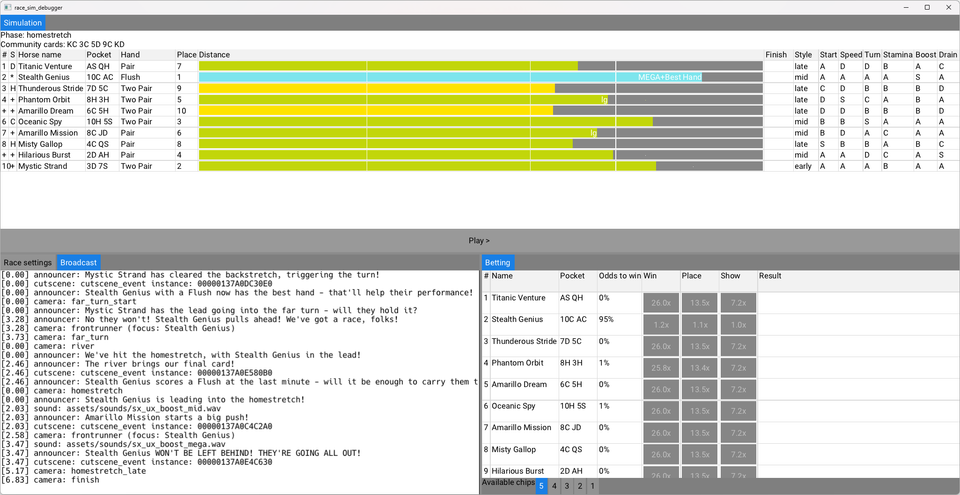What we’ve learned from Homestretch Bet (so far!)

Every company ends up with a unique culture based on the composition of folks that work there. Going through the process of synthesizing the concept for a game, proving out its mechanics, and putting it out gives you a sense of where your particular configuration is working well and where it needs some additional support.
With a new company, you also have to figure out how you do things. Brandon and I have worked together for years, but this is the first time that we have had the responsibility of composing the process from whole cloth. Our key takeaways after ‘shipping’ our first game from 2weeks are:
Communication
This is common wisdom, but always worth reiterating. Daily communication is critical—particularly in the homestretch(bet.com)—to ensure that the team is working towards the same end AND that everyone maintains alignment. This is easier the smaller your team is.
We were able to get away with a combination of consistent morning meetings supplemented by ad hoc calls. We also started using some of the task tracking features in Notion—mainly to make tasks crystal clear and to prioritize them. Production folks that have worked with me in the past would have been shocked at how well I maintained my task list.

Scoping
Paradoxically both the hardest and the easiest thing for me to do on a game. Every feature feels vital to the player experience, but! There is (or should be) a fixed amount of time that you can work on something before you need to get it out—games are notorious for filling the amount of time that you allot to them.
We decided to be aggressive about putting HSB out quickly and that was a lovely forcing function that helped us scope appropriately. This is another aspect of development that works best if you have a small team that is calling the shots and responsible for the work.

Plenty of folks use an MVP (minimum viable product) model for this, but we aren’t thinking in terms of market viability. We want to narrow down to the set of features that conveys the essence of the idea so that we can see if players connect to the concept. Here are some features we cut from the original design:
- Horse powers - Each horse had special abilities that activate when it has certain card combinations.
- Season meta structure - Persistence ‘stables’ of horses that go through a full ‘season’ of races.
- Exotic bets - Trifectas or superfectas as well as more game-y stuff like photo finish or come-from-behind victories.
Less MVP and more MVE (minimum viable experience). Probably too fine a distinction for some, but it’s working for us so far.
Shipping
Our ambitious schedule with HSB required us to “close the loop” and get through our version of a full development cycle. Another common development refrain is that getting reps in is great for improvement and learning. We’ve discovered where we are spending the bulk of our time (UI and wrangling art assets!) and we’re actively iterating on our workflow for HSB and for future projects.

Getting all the way through the development process allows this kind of analysis with more real data and less hypotheticals.
Plus! Iterating on the open web is a joy. We’ve already pushed a few updates to HSB and being able to quickly respond to bugs and player feedback is amazing.
Community
Feedback from an engaged community is the most valuable source of feedback that you can ask for. Folks taking the time to tell you how they feel about your game and which elements are working (or not) breaks the internal feedback loops and give you incredible new perspective on your game.
Occasional user research studies during development are lovely—and the science folks are applying to understanding player behavior is amazing—but what we’ve found to be the most effective over our careers is some form of alpha/beta/early access model where you get feedback directly from players and data gathered from a live game.
A core part of our thesis for 2weeks as a studio is that taking years of development time to craft the perfect player experience without having players involved leads to misalignment. There are a lot of recent examples of really cool game ideas—that had years of work, heart, and soul poured into them—that were unable to connect to their audience. We would like to find out quickly if the idea that we think is cool has a chance to connect and use that information to decide how much additional time to put into the project.
Homestretch Bet
We’re going to push HSB out in more places—there are a lot of great web game portals out there with tons of players—so that we can see how even more players engage with it. We’ve got a few more refinements that we’d like to make to the experience to make it easier to get information and to improve the mobile experience.
But the main thing that we’ve learned is how to make our next game better and get it to players even faster. We’re already cranking away on that game (KDC!) and we’re looking forward to talking about it soon!

